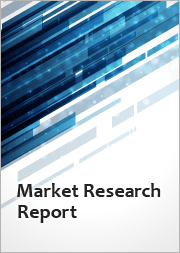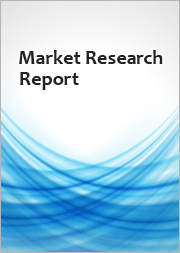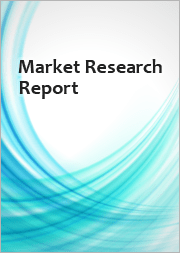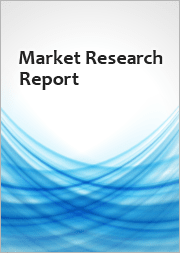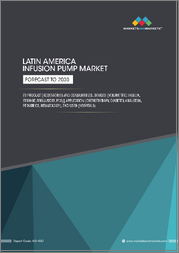
|
시장보고서
상품코드
1495982
혈액 진단 시장 - 예측(2024-2029년)Haematology Diagnostics Market - Forecasts from 2024 to 2029 |
||||||
혈액 진단 시장의 2022년 시장 규모는 65억 8,300만 달러로 연평균 6.18% 성장하여 2029년에는 100억 1,200만 달러에 달할 것으로 평가됩니다.
혈액학은 혈액과 혈액 관련 질환을 연구하는 학문입니다. 빈혈, 혈액암, 혈전 등 혈액과 관련된 질병 및 장애의 진단은 혈액 진단에 속합니다. 이러한 혈액 질환의 발병률은 지난 몇 년 동안 증가하고 있으며, 예측 기간 동안 혈액 진단 시장의 성장을 촉진할 것으로 예상되는 주요 요인 중 하나입니다.
또한, 혈액 진단의 기술 발전으로 인해 더욱 편리하고 효율성이 높아졌습니다. 시장의 지속적인 기술 혁신은 향후 몇 년 동안 시장 성장을 더욱 증가시킬 것으로 예상됩니다. 또한, 전 세계 노인 인구의 증가는 환자 수 증가로 이어져 평가 기간 동안 수요를 증가시킬 것으로 예상되는 또 다른 중요한 요인으로 작용할 것으로 예상됩니다.
시장 촉진요인:
- 혈액 질환의 증가로 혈액 진단 시장의 급격한 성장이 예상됩니다.
빈혈, 혈우병, 혈액암, 혈전 등 다양한 종류의 혈액 질환이 전 세계적으로 증가하고 있습니다. 빈혈은 이러한 질병 중 하나로, 빈혈의 보급률이 점점 더 높아지고 있습니다. 세계은행 자료에 따르면, 6-59개월 아동의 빈혈 유병률은 2010년 10.4%에서 2019년 13.2%로 증가했습니다. 핀란드에서는 2010년 10%에서 2019년 11.8%로, 덴마크에서는 2010년 12.6%에서 2019년 14.5%로 증가했습니다.
또한, 세계은행 자료에 따르면 가임기 여성 또는 15-59세 여성의 빈혈 유병률은 2013년 28.5%에서 2019년 29.9%로 급증했습니다. 또한, 혈액암 발병률은 빠른 속도로 증가하고 있으며, 이는 예측 기간 동안 혈액 진단 시장의 성장을 촉진할 것으로 예상됩니다.
미국암협회에 따르면 2021년 미국 내 백혈병 신규 발병 건수는 61,090건으로 추정됩니다. 또한 미국 내 백혈병 발병률은 같은 기간 남성의 경우 2009년 인구 10만 명당 18명에서 2017년 약 20명으로, 여성은 10.8명에서 11.8명으로 증가했다고 밝혔습니다. 호주 백혈병 재단은 혈액암 환자 수가 2020년 11만 명에서 2035년에는 27만 5,000명 이상이 될 것으로 예측하고 있습니다.
- 고령인구 증가로 혈액학 진단약 수요를 견인할 것으로 예상됩니다.
세계의 노인 인구는 지난 몇 년 동안 지속적으로 증가하고 있으며, 향후 몇 년 동안 더 증가할 것으로 예측됩니다. 노인 인구가 증가함에 따라 빈혈이나 백혈병과 같은 혈액 질환의 위험도 증가합니다. 조기 발견과 관리를 위해서는 정기적인 혈액학적 평가가 필수적입니다.
심혈관 질환 및 당뇨병과 같은 만성 질환도 혈액학적 매개변수에 영향을 미치기 때문에 혈액 진단은 혈액 구성에 미치는 영향을 모니터링하고 관련 합병증을 파악하는 데 필수적입니다. 미국에서는 65세 이상 노인 인구가 전체 인구에서 차지하는 비율이 2010년 12.98%에서 2020년 16.63%로 증가한다(출처: 세계은행). 중국도 노인 인구가 빠르게 증가하고 있는 국가입니다.
65세 이상 인구는 2010년 1,080억 1,200만 명에서 2020년 1,688억 6,400만 명으로 10년 동안 36% 이상 증가할 것으로 예상됩니다. 프랑스에서는 65세 이상 인구가 2010년 109억 5,800만 명에서 2020년 139억 8,600만 명으로 급증하여 27% 이상의 성장세를 보이고 있습니다. (출처: World Bank)
인구 고령화는 앞으로도 계속될 것으로 예상되며, 이는 환자 수 증가에 크게 기여할 것으로 예상됩니다. 이는 평가 기간 동안 세계 혈액 진단 시장에 긍정적인 영향을 미칠 것으로 예상됩니다.
북미가 큰 시장 점유율을 차지
지리적으로는 진단 센터가 풍부한 북미가 큰 시장 점유율을 차지할 것으로 예상됩니다. 또한, 선진화된 의료 시스템으로 인해 사람들은 혈액 질환을 쉽게 진단받을 수 있으며, 그 결과 이 지역의 혈액 진단 시장 규모가 커지고 있습니다.
북미는 의료 시설의 개선으로 많은 사람들이 필요한 의료 서비스를 받을 수 있게 됨에 따라 상당한 성장이 예상됩니다. 노인 인구와 총 인구의 증가는 예측 기간 동안 이 지역의 혈액 진단 시장 성장을 촉진할 것으로 예상되는 또 다른 중요한 이유입니다.
북미의 높은 의료 인프라, 혈액 질환의 높은 유병률, 만성 질환의 증가로 인해 고급 혈액 진단에 대한 수요가 증가하고 있습니다. 이 지역에서는 이러한 질병의 조기 진단과 모니터링에 대한 관심이 높아지면서 혈액 진단에 대한 수요를 견인하고 있습니다. 자동 분석기 및 분자진단과 같은 진단 분야의 기술 발전으로 인해 의료 서비스 제공자들은 최신 솔루션에 투자하고 있습니다. 또한, 현장 검사(point-of-care)의 보급이 확대되면서 시장 성장에 기여하고 있습니다.
주요 개발
- 2024년 2월 - 시스멕스(Sysmex Corporation)와 셀라비전(CellaVision)이 차세대 세포 형태 분석기를 포함한 포트폴리오를 확장해 혈액학 솔루션을 강화하기 위한 전략적 제휴 계약을 체결했습니다. 이 제휴는 적혈구, 백혈구 및 기타 혈액 세포를 분석하는 혈액학 분야에서 20년 전에 시작되었습니다. 이번 계약은 2038년까지 연장되며, 시스멕스의 혈액학 분야 검사 워크플로우 효율화 및 표준화에 대한 전문성을 활용하고 셀라비전의 디지털 이미지 처리 및 분석 기술과의 시너지를 극대화하기 위해 체결됐습니다.
- 2023년 8월 - Abbott는 Alinity h 시리즈 혈액 검사 시스템에 대한 FDA 승인을 획득했습니다. 이 시스템을 통해 검사실은 Alinity 진단 제품군의 일부로 전혈구 계산(CBC)을 수행할 수 있습니다. 이 시스템에는 자동 혈액학 분석기, 슬라이드 메이커 및 스테이너가 포함되어 있으며, Alinity h 시리즈는 의사가 환자를 빠르고 효과적으로 치료하는 데 사용할 수 있는 다양한 검사를 포함하고, 시간당 최대 119건의 CBC 결과를 처리할 수 있으며, 설치 공간이 적고, 결과 및 제어 기능을 중앙 집중화할 수 있습니다. 결과와 제어 기능을 중앙에서 관리할 수 있는 등의 장점이 있습니다.
- 2023년 7월 - Sysmex Europe SE는 실험실용 혈액학 주력 제품군인 XR 시리즈를 발표했습니다. 이 제품 라인은 이전 제품인 XN 시리즈의 신뢰성과 기술을 기반으로 합니다. 실험실의 요구에 부응하기 위해 새로운 자산과 처리량 향상 기능을 추가했습니다. 일본에서 출시된 XR 시리즈는 전 세계 고객의 강점을 반영하고 있습니다. 혈액 검사실에서는 바코드 판독, 튜브 분류, 도말 관리, 시약 관리를 자동화할 수 있습니다. 알랭 바브렐(Alain Baverel) 사장 겸 CEO는 XR-Series는 검사실에 신뢰할 수 있는 선택이라며, 혈액 검사에서 신뢰할 수 있는 진단과 서비스를 제공하는 것을 목표로 하고 있다고 말했습니다.
주요 시장 세분화
검사 유형별
- 헤모글로빈
- 혈구 수
- 혈소판 기능
- 헤마토크릿
- 기타
최종사용자별
- 병원 및 클리닉
- 진단센터
- 기타
지역별
- 북미
- 미국
- 캐나다
- 멕시코
- 남미
- 브라질
- 아르헨티나
- 기타
- 유럽
- 독일
- 프랑스
- 영국
- 기타
- 중동 및 아프리카
- 사우디아라비아
- 아랍에미레이트연합
- 기타
- 아시아태평양
- 중국
- 인도
- 일본
- 한국
- 대만
- 태국
- 인도네시아
- 기타
목차
제1장 소개
- 시장 개요
- 시장 정의
- 조사 범위
- 시장 세분화
- 통화
- 가정
- 기준 연도와 예측 연도 타임라인
- 이해관계자에 대한 주요 이점
제2장 조사 방법
- 조사 디자인
- 조사 과정
제3장 주요 요약
- 주요 조사 결과
제4장 시장 역학
- 시장 성장 촉진요인
- 시장 성장 억제요인
- Porter's Five Forces 분석
- 업계 밸류체인 분석
- 애널리스트의 견해
제5장 혈액 진단 시장 : 검사 유형별
- 소개
- 헤모글로빈
- 혈구수
- 혈소판 기능
- 적혈구 용적률
- 기타
제6장 혈액 진단 시장 : 최종사용자별
- 소개
- 병원과 클리닉
- 진단 센터
- 기타
제7장 혈액 진단 시장 : 지역별
- 소개
- 북미
- 남미
- 유럽
- 중동 및 아프리카
- 아시아태평양
제8장 경쟁 환경과 분석
- 주요 기업과 전략 분석
- 시장 점유율 분석
- 합병, 인수, 합의와 협업
- 경쟁 대시보드
제9장 기업 개요
- Bio-Rad Laboratories, Inc.
- Boule Diagnostics AB
- Abbott Laboratories
- Diatron
- Biosystems S.A.
- F. Hoffmann-La Roche Ltd
- Horiba, Ltd.
- Erba Diagnostics Mannheim GmbH
- Ortho Clinical Diagnostics
- Shenzhen Mindray Bio-Medical Electronics Co., Ltd.
The haematology diagnostics market is evaluated at USD6.583 billion for the year 2022, growing at a CAGR of 6.18% to reach the market size of USD10.012 billion by the year 2029.
Haematology is the study of blood and blood-related diseases. The diagnosis of diseases or disorders related to blood, including anemia, blood cancer, and blood clots, among others, comes under the umbrella of haematology diagnostics. The incidences of such blood disorders have been increasing over the past years and are one of the major factors anticipated to drive the haematology diagnostics market growth during the forecast period.
Furthermore, the technological advancements in haematology diagnostics have made it more convenient and efficient. The continuous innovation in the market is expected to augment the market growth further in the coming years as well. Moreover, the growing geriatric population worldwide leads to an increase in the number of patients and is another prominent factor anticipated to boost the demand during the assessment period.
Market Drivers:
- Rising incidences of blood disorders is expected to surge the Haematology Diagnostics Market.
Various kinds of blood disorders are on the rise worldwide, including anemia, hemophilia, blood cancer, and blood clots, among others. Anemia is one such widely prevalent disorder that is increasing its pervasiveness. According to data from the World Bank, the prevalence of anemia among children aged 6-59 months has increased from 10.4% in 2010 to 13.2% in 2019. In Finland, it has increased from 10% in 2010 to 11.8% in 2019, while in Denmark, it reached 14.5% in 2019, rising from 12.6% in 2010.
Furthermore, the data from the World Bank shows that the global prevalence of anemia among women of reproductive age or women aged 15 to 59 years has jumped from 28.5% in 2013 to 29.9% in 2019. Moreover, the cases of blood cancer are increasing at a fast pace, which is expected to propel the haematology diagnostics market growth during the forecast period.
The American Cancer Society states that the estimated new cases of leukemia in the United States in 2021 will be 61,090. It also states that the incidence rate of leukemia in the U.S. has increased from 18 in 2009 to around 20 per 100,000 population in 2017 for males and from 10.8 to 11.8 for females during the same time period. The Leukaemia Foundation in Australia projects the number of blood cancer cases from 110,000 in 2020 to more than 275,000 in 2035.
- Growing geriatric population is anticipated to drive the demand for haematology diagnostics
The global elderly population has been rising over the past years and is projected to further grow in the coming years as well. As the geriatric population ages, the risk of hematological disorders like anemia and leukemia increases. Regular haematological assessments are crucial for early detection and management.
Chronic diseases like cardiovascular diseases and diabetes also impact haematological parameters, making haematology diagnostics essential for monitoring their effects on blood composition and identifying associated complications. In the United States, the share of the elderly population aged 65 and above in the total population has increased from 12.98% in 2010 to 16.63% in 2020, as per the World Bank. China is another country witnessing a rapid rise in its geriatric population.
The population aged 65 and above reached 168.864 billion in the country in 2020, jumping from 108.012 billion in 2010, witnessing a growth of more than 36% over a decade. In France, the population aged 65 and above has surged from 10.958 billion in 2010 to 13.986 billion in 2020, growing by more than 27%. (Source: World Bank)
The population is anticipated to continue to age in the coming years, contributing significantly to the rise in the number of patients. This is anticipated to have a positive impact on the global haematology diagnostics market during the assessment period.
The North American region holds a significant market share
Geographically, the North American region is projected to hold a significant market share owing to the presence of diagnostic centers in abundance. Furthermore, an advanced healthcare system makes it simple for people to get their blood disorders diagnosed and consequently results in a significant market size of haematology diagnostics in the region.
The North American region is projected to witness substantial growth due to improved medical facilities leading to a higher number of people getting access to the needed healthcare services. The rising geriatric population and the overall population are other prominent reasons anticipated to propel the market growth of haematology diagnostics in this region during the forecast period.
North America's advanced healthcare infrastructure, high prevalence of haematological disorders, and rising incidence of chronic diseases drive demand for advanced haematology diagnostics. The region's focus on early diagnosis and monitoring of these conditions drives the demand for haematology diagnostics. Technological advancements in diagnostics, such as automated analyzers and molecular diagnostics, attract healthcare providers to invest in modern solutions. Point-of-care testing is also gaining popularity, contributing to market growth.
Key Developments:
- February 2024- Sysmex Corporation and CellaVision entered a strategic alliance agreement to advance haematology solutions by expanding their portfolio, including next-generation cell morphology analyzers. The partnership began 20 years ago in the field of haematology, which analyzes red, white, and other blood cells. The agreement will extend until 2038 and will utilize Sysmex's expertise in enhancing efficiency and standardization of testing workflow in the haematology field, while maximizing synergies with CellaVision's digital imaging and analysis technologies. The goal is to enhance efficiency and standardization in the testing workflow and improve clinical value in supporting diagnoses.
- August 2023- Abbott received FDA clearance for its Alinity h-series haematology system, allowing laboratories to run complete blood counts (CBC) as part of its Alinity family of diagnostic products. The system includes an automated haematology analyzer and an integrated slide maker and stainer. The Alinity h-series offers a wide array of tests doctors can use to quickly and effectively care for their patients. It offers advantages such as processing up to 119 CBC results per hour, requiring less floor space, and centralized results and control functions.
- July 2023- Sysmex Europe SE introduced the XR-Series, its flagship product line for laboratory haematology. The line builds on the reliability and technology of its predecessor, the XN-Series. It offers new assets and improved throughput to meet laboratory needs. Launched in Japan, the XR-Series incorporates the strengths of customers worldwide. Haematology labs can automate barcode reading, tube sorting, smear management, and reagent management. President and CEO Alain Baverel aim to continue providing reliable diagnostics and services in haematology, stating that the XR-Series is a reliable option for labs.
Key Market Segmentation:
By Test Type
- Hemoglobin
- Blood Count
- Platelet Function
- Hematocrit
- Others
By End-User
- Hospitals and Clinics
- Diagnostic Centers
- Others
By Geography
- North America
- USA
- Canada
- Mexico
- South America
- Brazil
- Argentina
- Others
- Europe
- Germany
- France
- UK
- Others
- Middle East and Africa
- Saudi Arabia
- UAE
- Others
- Asia Pacific
- China
- India
- Japan
- South Korea
- Taiwan
- Thailand
- Indonesia
- Others
TABLE OF CONTENTS
1. INTRODUCTION
- 1.1. Market Overview
- 1.2. Market Definition
- 1.3. Scope of the Study
- 1.4. Market Segmentation
- 1.5. Currency
- 1.6. Assumptions
- 1.7. Base and Forecast Years Timeline
- 1.8. Key Benefits to the Stakeholder
2. RESEARCH METHODOLOGY
- 2.1. Research Design
- 2.2. Research Processes
3. EXECUTIVE SUMMARY
- 3.1. Key Findings
4. MARKET DYNAMICS
- 4.1. Market Drivers
- 4.2. Market Restraints
- 4.3. Porter's Five Forces Analysis
- 4.3.1. Bargaining Power of Suppliers
- 4.3.2. Bargaining Power of Buyers
- 4.3.3. Threat of New Entrants
- 4.3.4. Threat of Substitutes
- 4.3.5. Competitive Rivalry in the Industry
- 4.4. Industry Value Chain Analysis
- 4.5. Analyst View
5. HAEMATOLOGY DIAGNOSTICS MARKET BY TEST TYPE
- 5.1. Introduction
- 5.2. Hemoglobin
- 5.2.1. Market Opportunities and Trends
- 5.2.2. Growth Prospects
- 5.2.3. Geographic Lucrativeness
- 5.3. Blood Count
- 5.3.1. Market Opportunities and Trends
- 5.3.2. Growth Prospects
- 5.3.3. Geographic Lucrativeness
- 5.4. Platelet Function
- 5.4.1. Market Opportunities and Trends
- 5.4.2. Growth Prospects
- 5.4.3. Geographic Lucrativeness
- 5.5. Hematocrit
- 5.5.1. Market Opportunities and Trends
- 5.5.2. Growth Prospects
- 5.5.3. Geographic Lucrativeness
- 5.6. Others
- 5.6.1. Market Opportunities and Trends
- 5.6.2. Growth Prospects
- 5.6.3. Geographic Lucrativeness
6. HAEMATOLOGY DIAGNOSTICS MARKET BY END-USER
- 6.1. Introduction
- 6.2. Hospitals and Clinics
- 6.2.1. Market Opportunities and Trends
- 6.2.2. Growth Prospects
- 6.2.3. Geographic Lucrativeness
- 6.3. Diagnostic Centers
- 6.3.1. Market Opportunities and Trends
- 6.3.2. Growth Prospects
- 6.3.3. Geographic Lucrativeness
- 6.4. Others
- 6.4.1. Market Opportunities and Trends
- 6.4.2. Growth Prospects
- 6.4.3. Geographic Lucrativeness
7. HAEMATOLOGY DIAGNOSTICS MARKET BY GEOGRAPHY
- 7.1. Introduction
- 7.2. North America
- 7.2.1. By Test Type
- 7.2.2. By End-User
- 7.2.3. By Country
- 7.2.3.1. USA
- 7.2.3.1.1. Market Opportunities and Trends
- 7.2.3.1.2. Growth Prospects
- 7.2.3.2. Canada
- 7.2.3.2.1. Market Opportunities and Trends
- 7.2.3.2.2. Growth Prospects
- 7.2.3.3. Mexico
- 7.2.3.3.1. Market Opportunities and Trends
- 7.2.3.3.2. Growth Prospects
- 7.2.3.1. USA
- 7.3. South America
- 7.3.1. By Test Type
- 7.3.2. By End-User
- 7.3.3. By Country
- 7.3.3.1. Brazil
- 7.3.3.1.1. Market Opportunities and Trends
- 7.3.3.1.2. Growth Prospects
- 7.3.3.2. Argentina
- 7.3.3.2.1. Market Opportunities and Trends
- 7.3.3.2.2. Growth Prospects
- 7.3.3.3. Others
- 7.3.3.3.1. Market Opportunities and Trends
- 7.3.3.3.2. Growth Prospects
- 7.3.3.1. Brazil
- 7.4. Europe
- 7.4.1. By Test Type
- 7.4.2. By End-User
- 7.4.3. By Country
- 7.4.3.1. Germany
- 7.4.3.1.1. Market Opportunities and Trends
- 7.4.3.1.2. Growth Prospects
- 7.4.3.2. France
- 7.4.3.2.1. Market Opportunities and Trends
- 7.4.3.2.2. Growth Prospects
- 7.4.3.3. UK
- 7.4.3.3.1. Market Opportunities and Trends
- 7.4.3.3.2. Growth Prospects
- 7.4.3.4. Others
- 7.4.3.4.1. Market Opportunities and Trends
- 7.4.3.4.2. Growth Prospects
- 7.4.3.1. Germany
- 7.5. Middle East and Africa
- 7.5.1. By Test Type
- 7.5.2. By End-User
- 7.5.3. By Country
- 7.5.3.1. Saudi Arabia
- 7.5.3.1.1. Market Opportunities and Trends
- 7.5.3.1.2. Growth Prospects
- 7.5.3.2. UAE
- 7.5.3.2.1. Market Opportunities and Trends
- 7.5.3.2.2. Growth Prospects
- 7.5.3.3. Others
- 7.5.3.3.1. Market Opportunities and Trends
- 7.5.3.3.2. Growth Prospects
- 7.5.3.1. Saudi Arabia
- 7.6. Asia Pacific
- 7.6.1. By Test Type
- 7.6.2. By End-User
- 7.6.3. By Country
- 7.6.3.1. China
- 7.6.3.1.1. Market Opportunities and Trends
- 7.6.3.1.2. Growth Prospects
- 7.6.3.2. India
- 7.6.3.2.1. Market Opportunities and Trends
- 7.6.3.2.2. Growth Prospects
- 7.6.3.3. Japan
- 7.6.3.3.1. Market Opportunities and Trends
- 7.6.3.3.2. Growth Prospects
- 7.6.3.4. South Korea
- 7.6.3.4.1. Market Opportunities and Trends
- 7.6.3.4.2. Growth Prospects
- 7.6.3.5. Taiwan
- 7.6.3.5.1. Market Opportunities and Trends
- 7.6.3.5.2. Growth Prospects
- 7.6.3.6. Thailand
- 7.6.3.6.1. Market Opportunities and Trends
- 7.6.3.6.2. Growth Prospects
- 7.6.3.7. Indonesia
- 7.6.3.7.1. Market Opportunities and Trends
- 7.6.3.7.2. Growth Prospects
- 7.6.3.8. Others
- 7.6.3.8.1. Market Opportunities and Trends
- 7.6.3.8.2. Growth Prospects
- 7.6.3.1. China
8. COMPETITIVE ENVIRONMENT AND ANALYSIS
- 8.1. Major Players and Strategy Analysis
- 8.2. Market Share Analysis
- 8.3. Mergers, Acquisitions, Agreements, and Collaborations
- 8.4. Competitive Dashboard
9. COMPANY PROFILES
- 9.1. Bio-Rad Laboratories, Inc.
- 9.2. Boule Diagnostics AB
- 9.3. Abbott Laboratories
- 9.4. Diatron
- 9.5. Biosystems S.A.
- 9.6. F. Hoffmann-La Roche Ltd
- 9.7. Horiba, Ltd.
- 9.8. Erba Diagnostics Mannheim GmbH
- 9.9. Ortho Clinical Diagnostics
- 9.10. Shenzhen Mindray Bio-Medical Electronics Co., Ltd.






